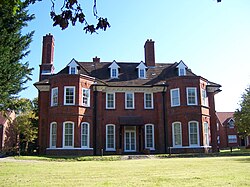Our website is made possible by displaying online advertisements to our visitors.
Please consider supporting us by disabling your ad blocker.
Highgrove House, Eastcote
| Highgrove House | |
|---|---|
 Highgrove House viewed from the east | |
| General information | |
| Architectural style | Queen Anne and Early Georgian |
| Location | Eastcote |
| Town or city | Greater London |
| Country | England |
| Coordinates | 51°34′54″N 0°24′28″W / 51.581667°N 0.407778°W |
| Construction started | 1747 (first house) 1879 (second house) |
| Completed | 1750 (first house) 1881 (second house) |
| Client | Reverend John Lidgould (first house) Sir Hugh Hume-Campbell (second house) |
| Design and construction | |
| Architect(s) | Edward Prior (second house) |
Highgrove House, also known as High Grove House or High Grove, is a Grade II listed mansion in the suburban area of Eastcote, within the London Borough of Hillingdon.[1] Originally built in 1750 by the Reverend John Lidgould, the house was rebuilt in 1881 by Sir Hugh Hume-Campbell following a catastrophic fire. Along with Haydon Hall and Eastcote House, Highgrove was one of the three main houses of Eastcote and eventually became a residential hostel for homeless families, run by the local council from the 1960s until 2007. An area of the estate was sold to the local council in 1935 by the then-owner Eleanor Warrender to become what is now Warrender Park. In 1975, the house was granted Grade II listed status on account of its special architectural character.
The house was subsequently closed as a hostel by the council and sold for £1.295m to Westcombe Estates. Planning permission was granted to the new owners in January 2007 for the conversion of the building into a luxury housing block of 12 units and expanded for a further three years in February 2010.[2]
- ^ "Listed buildings" (PDF). London Borough of Hillingdon. Archived from the original (PDF) on 8 June 2011. Retrieved 17 June 2011.
- ^ Cracknell, James (4 May 2010). "Restoration of historic Eastcote house moves forward". Uxbridge Gazette. Retrieved 25 May 2011.
Previous Page Next Page



